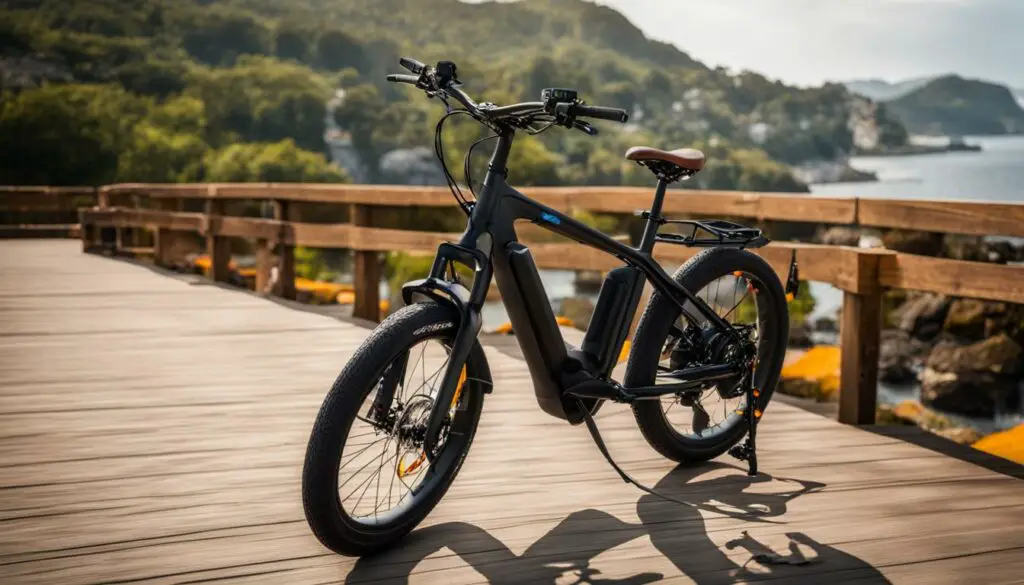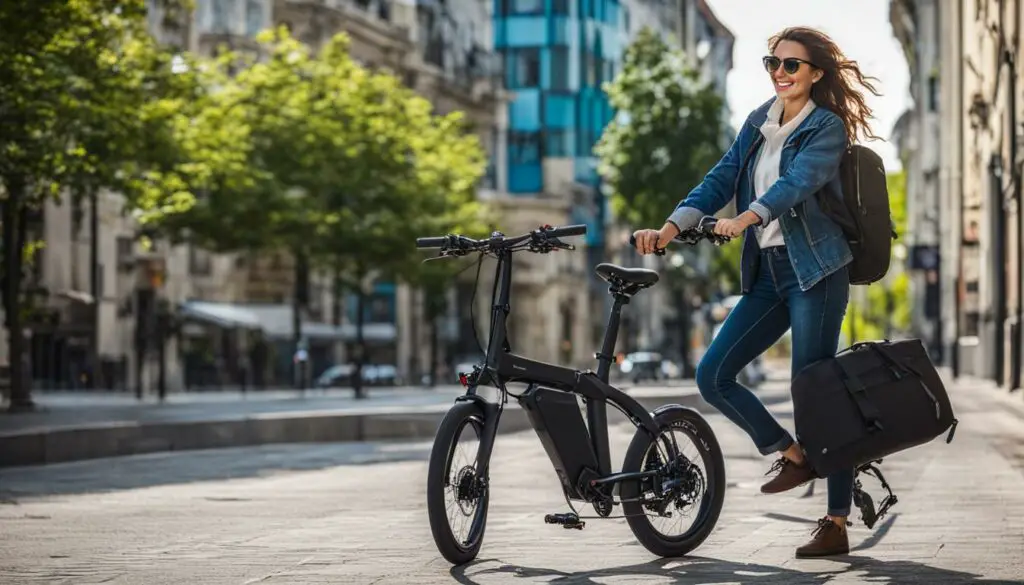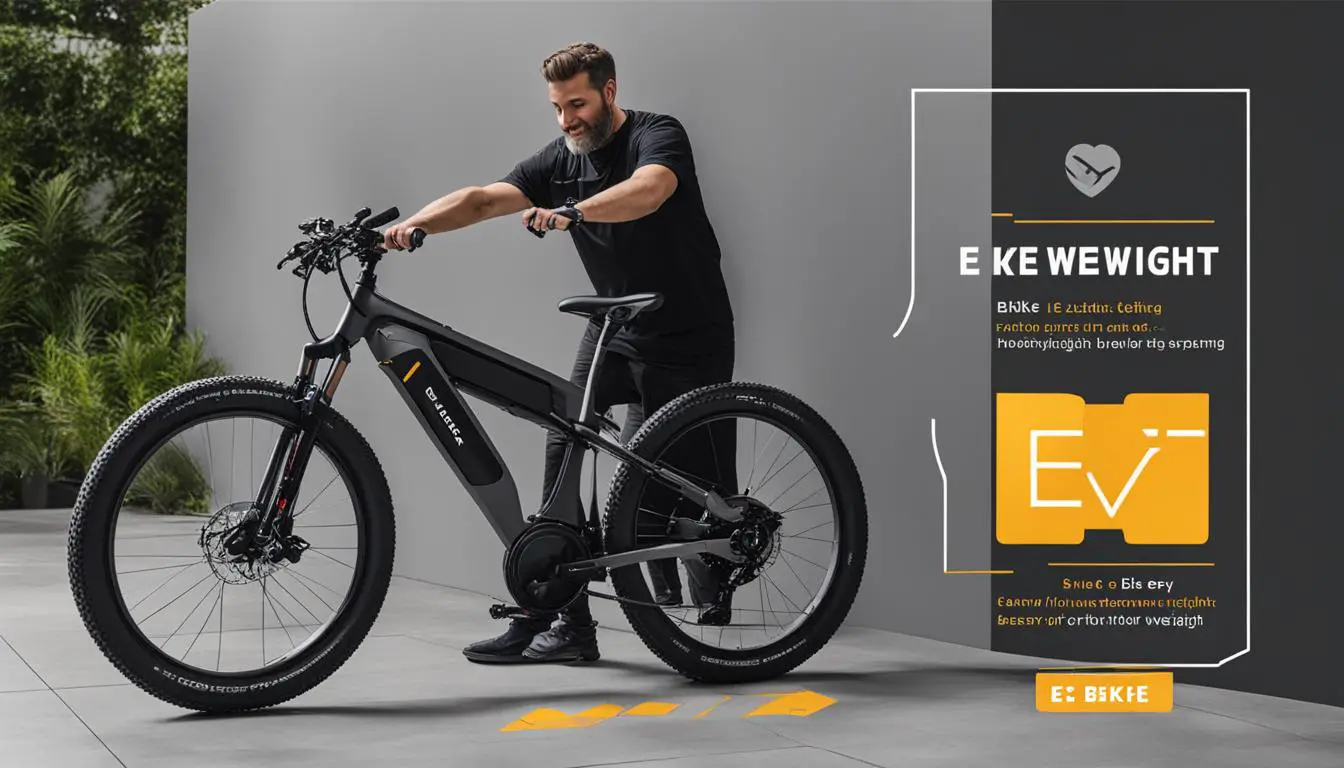Are E-Bikes Heavy? A Quick Guide to Weight Facts
Originally posted on December 20, 2023 @ 8:24 pm
If you are curious about the details of electric bicycles’ weight and wondering if they are heavy, you are not alone. As e-bikes become increasingly popular, it is crucial to examine their weight and how it may affect your cycling experience. Generally, electric bikes weigh slightly more than traditional bikes due to the added motor and battery. These components, which allow for easier pedaling and potentially faster speeds, contribute to a weight range of 40 to 80 pounds.
However, the added weight does not come without benefits. While it may sound counterintuitive, the weight of e-bikes often correlates with enhanced stability and durability, making it an asset rather than a hindrance, especially for certain types of riding. But for those of you who prioritize portability and handling above all, the market does offer lighter e-bike models, though they may sport smaller motors and batteries, influencing your cruising distance.
Your riding intent, whether that’s breezing through urban landscapes or braving roughest terrains, will largely dictate your preference when it comes to choosing your electric ride’s weight class. Let’s unpack the factors that add those extra pounds and how they can benefit or detract from your biking experience.
Key Takeaways
- Electric bikes vary in weight mostly due to the motor and battery, making them heavier than traditional bicycles.
- Lighter e-bike options offer better handling and are easier to transport.
- The weight of e-bikes is a crucial consideration for matching an e-bike to your personal usage needs.
- Heavier e-bikes may provide greater stability and extended range, important for certain riding conditions.
- A spectrum of electric bike models exists to cater to diverse preferences, balancing the trade-offs between weight and performance.
Understanding E-Bike Weight Fundamentals
With the surge in popularity of electric bikes (e-bikes), understanding the fundamental elements contributing to e bike heaviness is essential for riders considering a purchase. While the assistance of an electric motor offers ease and speed, it inevitably adds to the weight of the bike. This weight factor influences not just the riding experience but also the functionality and suitability of the e-bike for different terrains and uses.
Factors That Contribute to E-Bike Heaviness
When evaluating the heavy electric bicycles on the market, several key components are responsible for the additional pounds. The electric motor and battery are the prime culprits, contributing a substantial amount of weight. Alongside these, the construction of the e-bike itself, with its reinforced frame and larger wheel size for stability and traction, adds on more weight. Furthermore, the type of material used—typically sturdier metals like steel or aluminum—ensures durability but increases the overall heft of the e-bike.

Comparing E-Bike Weight to Traditional Bicycles
There is a noticeable difference when you compare an e-bike’s weight to that of a traditional bicycle. The lack of electrical components in standard bikes makes them significantly lighter and sometimes more maneuverable. However, the robust nature of e-bike heaviness provides added stability and the ability to tackle a variety of terrains with less effort on the rider’s part.
The Impact of Motors and Batteries on Weight
The motors and batteries, the heart and soul of an e-bike, have a significant impact on weight. The convenience and range afforded by these components have a trade-off in the form of added weight. The table below outlines general weights for motors and batteries, giving you an idea of how they contribute to the electric bike weight limit.
| Type | Motor Weight | Battery Weight | Total Added Weight |
|---|---|---|---|
| Racing E-Bikes | 4-6 lbs | 5-8 lbs | 9-14 lbs |
| Mountain E-Bikes | 6-8 lbs | 6-10 lbs | 12-18 lbs |
| Fat Tire E-Bikes | 6-8 lbs | 8-12 lbs | 14-20 lbs |
| Commuter E-Bikes | 5-7 lbs | 10-15 lbs | 15-22 lbs |
Are E-Bikes Heavy? Breaking Down the Average Weights
When you consider diving into the world of electric biking, one of the prime factors to evaluate is the e bike weight comparison among various models. You may be pondering over how lightweight e bikes stack up against heavy vs lightweight e bikes. Let’s shed some light on this subject to help you make an informed decision.
The weight plays a critical role not only in maneuverability but also in portability and range. An e-bike’s weight typically results from the integration of the motor and battery—two integral components that define the essence of an electric bike. It’s these components that can tip the scales, with motors alone weighing anywhere from a nimble 4.4 pounds up to a robust 17.6 pounds, influenced by their type and power output.
On the subject of batteries, these powerhouses are no lightweight matter either, contributing a significant chunk to the e-bike’s overall mass. Batteries can weigh in between a moderate 10 pounds up to a heftier 20 pounds. Beyond weight alone, the battery’s capacity is pivotal in determining the range and endurance of your ride, marking its significance in the architects of an e-bike’s design.
To better grasp the differences, here’s a comprehensive table that compares some of the popular e-bike styles based on their average weights.
| E-Bike Type | Average Motor Weight | Average Battery Weight | Total Average Weight |
|---|---|---|---|
| City/Urban | 6.2 lbs | 12.5 lbs | 44 lbs |
| Mountain | 8.5 lbs | 15 lbs | 55 lbs |
| Folding | 5.7 lbs | 11 lbs | 38 lbs |
| Cargo | 9 lbs | 18 lbs | 60 lbs |
This table reveals that there’s a model to suit every need, whether you’re in the market for a more manageable lightweight e bike or require the muscle of a heavier counterpart. Thus, the decision on the optimal e-bike weight will tailor to your personal cycling habits and utilization.

Commuter E-Bikes: A Balance of Comfort and Weight
If your journey involves a mix of comfort and durability, commuter e-bikes are the sweet spot with weights that range from 50 to 70 pounds. The additional weight primarily comes from larger battery packs necessitated by longer commutes, ensuring you have enough power to get to your destination without frequent recharging.
Performance E-Bikes: Racing and Mountain Models
For the speed enthusiasts and off-road adventurers, performance e-bikes span the category of lightweight e-bikes to more robust models. Racing e-bikes are built for speed and performance, weighing approximately 40 pounds. Mountain e-bikes, tailored to handle challenging terrains, have weights varying from 40 to 70 pounds, to accommodate for high-power output motors, which can reach up to 750W, and heavy-duty suspension systems.
Whether you’re after the ease of a lightweight folding bike to hop on the train, a reliable commuter e-bike for city travel, or a sturdy mountain e-bike for exploring the trails, the e bike weight comparison chart is a critical tool to guide your choice. Each type of e-bike is engineered with purpose, striking a balance between weight and performance to best suit the ride ahead of you.
How Weight Affects Your Riding Experience
As you delve into the world of electric bikes, understanding how the weight impacts your ride is paramount. While heavyweight e-bikes provide a solid and stable ride, they may challenge your maneuverability. On the flip side, lightweight e-bikes offer an undeniable ease and agility, but this may come at the cost of power and range. This section will help you balance these elements to find your perfect e-bike fit within the electric bike weight limit.
Handling and Maneuverability Concerns
Maneuverability is often the first casualty when you opt for a heavier e-bike. Those extra pounds can make it difficult to navigate tight corners or swiftly change direction, which is particularly noticeable in urban environments. Consider how the added stability of heavyweight e bikes could be beneficial when riding in less-than-ideal conditions, like on uneven trails or during windy weather.
The Range Factor: Battery Life and Weight
It’s a simple equation: a heavier e-bike typically means a larger battery, and larger batteries often translate to longer ranges. However, this can also mean increased charging time and weight. Riders must weigh (no pun intended) the advantages of extended range against the ease of a lightweight e-bike that promises shorter, more nimble trips without the concern of a hefty battery.
Material Considerations: Frame Weight Differences
The materials used in e-bike frames are integral to their overall weight. While steel frames carry the reputation of durability, their heft is undeniable. Aluminium strikes a middling weight category, offering both resilience and relatively lower weight. For those willing to invest more, carbon fiber or titanium frames present a lightweight solution to the electric bike weight limit without compromising strength.
Here is a breakdown of average frame materials and their corresponding weights:
| Frame Material | Average Weight (lbs) | Benefits |
|---|---|---|
| Steel | 20-22 | High durability, lower cost |
| Aluminium | 15-17 | Good balance of weight and strength |
| Carbon Fiber | 10-12 | Exceptional lightness, strength |
| Titanium | 12-14 | Lightweight, corrosion-resistant |
Remember, the joy of riding shouldn’t be overshadowed by the weight of your e-bike. Whether you’re after a heavyweight e-bike that promises to endure the toughest terrains or a sleek lightweight e-bike for zipping through the streets, your choices should align with your riding habits, environment, and the unique blend of speed and convenience you desire within the electric bike weight limit.

Choosing the Right E-Bike: Heavy vs Lightweight Options
When scanning the electric bike market, the question of are e bikes heavy often surfaces as a pivotal deciding factor. It’s essential to consider the diverse ways in which an e-bike’s weight can shape your every move. Below let’s delve into the realms of urban commuting and off-road adventures, and how each caters to different e-bike weight classes.
Urban Commuting: Navigating City Streets with Lighter E-Bikes
The swift navigation through bustling streets and the daily race against time favor the lighter e-bikes. Their ease of handling simplifies the urban commute, making storage and transportation between rides a breeze. Despite lighter e-bikes tending to have a smaller battery capacity, the tradeoff can be worth considering. For the city dweller, the criterion of e bike heaviness takes a backseat to agility.
Off-Road and Long-Distance: When a Heavier E-Bike Makes Sense
If your endeavors include challenging terrains or long stretches of open road, a heavier e-bike can provide significant advantages. Larger batteries and more robust motors, while augmenting the weight of e bikes, deliver the necessary power to conquer hills and extended trails. It’s a compromise designed in favor of performance and endurance.
Cost Implications of E-Bike Materials and Weight
Lastly, the interplay between cost and the choice of e-bike material—for example, between aluminum and carbon fiber—merits attention. The former offers a more cost-effective solution, albeit at a slightly higher weight, while the latter can deliver a lighter ride at a premium.
| Criteria | Lightweight E-Bike | Heavyweight E-Bike |
|---|---|---|
| Battery Capacity | Lower | Higher |
| Motor Power | Sufficient for city use | Optimized for tough terrains |
| Handling | More maneuverable | Stable, less agile |
| Cost | More affordable | Can be higher due to materials |
Conclusion
As you navigate the burgeoning world of electric mobility, the question of whether are e-bikes heavy looms large. While it’s clear that the electric bikes weight more than their traditional counterparts, largely due to the motors and batteries, they also offer a distinct blend of power and convenience. The pivotal question you face is what balance of weight and functionality best suits your daily life and the environment in which you’ll ride.
Whether you’re weaving through bustling city streets or braving the rugged trails, the canny selection of an e-bike requires consideration of how the weight impacts performance, battery range, and the ease with which you can transport your bike. In your quest for the perfect ride, understanding the spectrum of weights—from light, nimble models to heavy electric bicycles crafted for adventure—is critical. It ensures that you not only meet your transport needs but also enjoy the ride to its fullest.
Ultimately, by weighing these factors thoughtfully, you’ll discover an e-bike that resonates with your riding objectives and personal style. The industry’s vast array of options means there’s an e-bike out there engineered just for you. So dive in, empower your commute, and embrace the electric future on two wheels, expertly tailored to your life’s pace and places.
FAQ
Are e-bikes generally heavier than traditional bicycles?
Yes, e-bikes are generally heavier than traditional bicycles due to the additional weight of the motor, battery, and other electrical components. This can add around 20 pounds or more to the total weight.
What factors contribute to the weight of an e-bike?
The weight of an e-bike is influenced by the motor and battery size, the frame material, the type of e-bike, and components such as the suspension system and wheels designed for specific terrains.
How does the weight of the motor and battery impact an e-bike’s weight?
The motor and battery are the heaviest components of an e-bike, with motors averaging between 4.4 to 11 pounds and batteries commonly weighing between 10 to 20 pounds. Together, they significantly contribute to the total weight of the e-bike.
What is the average weight range for electric bikes?
The average weight range for electric bikes is approximately 40 to 80 pounds, with variations based on the type and model of the e-bike.
Are there lightweight e-bike options available?
Yes, there are lightweight e-bike options available that prioritize ease of handling and maneuverability, often weighing around 40 to 50 pounds depending on their design and intended use.
How do different types of e-bikes compare in weight?
Different types of e-bikes vary in weight due to their specific functions. For example, folding e-bikes range from 30 to 70 pounds, commuter e-bikes weigh about 50 to 70 pounds, while performance e-bikes, like racing models, are among the lighter options at around 40 pounds.
What role does the frame material play in the weight of an e-bike?
The frame material plays a significant role in the weight of an e-bike. Materials like steel and aluminum are durable but add weight, whereas materials like carbon fiber and titanium are lighter but more expensive.
How does weight affect the maneuverability of an e-bike?
Heavier e-bikes might offer less agility, especially on sharp turns or steep inclines, whereas lighter e-bikes typically provide better maneuverability and are easier to handle physically.
Is there a difference in battery life between heavier and lighter e-bikes?
Heavier e-bikes often come with larger batteries to support their powerful motors, resulting in longer battery life. Lighter e-bikes may have smaller batteries, which could mean a shorter range.
What should I consider if I am looking for an e-bike for urban commuting?
For urban commuting, a lighter e-bike could be more beneficial for navigating city traffic and may be easier to carry up stairs or onto public transportation. A lighter e-bike with a smaller battery may suffice for shorter commutes.
Why might someone choose a heavier e-bike?
Someone might choose a heavier e-bike for its increased power, durability, and stability, which are advantageous for off-road trails and long-distance rides.
Does a heavier e-bike affect the electric bike weight limit?
Yes, the weight of the e-bike does affect the overall weight limit as each bike is designed to handle a certain maximum weight, including the rider and cargo. Heavier e-bikes may have a higher weight limit, accommodating heavier riders or additional cargo.
What is the impact of an e-bike’s weight when transporting it?
A heavier e-bike can be more challenging to transport due to its weight, making it harder to lift onto bike racks and requiring more effort to carry when not riding.
How does the weight of an e-bike influence its cost?
The weight of an e-bike, particularly when reduced through the use of advanced light materials like carbon fiber, often increases the cost due to the expense of these higher-end materials.








